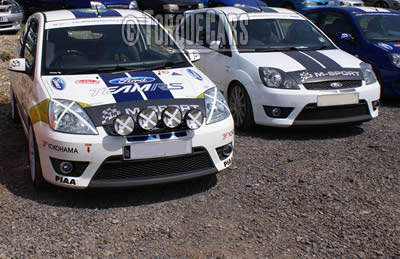Ford Fiesta XR2 Mark I (1976–1983) Parts 5
Saturday, February 12, 2011
1:47 PM
,
0 Comments
ป้ายกำกับ: Article , Cars. Cars Article , Classic Cars , Classic Cars Article , Club , Convertible Cars , Convertible Classic Cars , Ford Fiesta XR2 , Ford Fiesta XR2 Cars , New , Xr2 Cars , XR2 Mark 1 , XR2 Mk 1 , XR2 Mk I
ป้ายกำกับ: Article , Cars. Cars Article , Classic Cars , Classic Cars Article , Club , Convertible Cars , Convertible Classic Cars , Ford Fiesta XR2 , Ford Fiesta XR2 Cars , New , Xr2 Cars , XR2 Mark 1 , XR2 Mk 1 , XR2 Mk I
Ford Fiesta XR2
Ford Fiesta XR2 Mark I (1976–1983) Parts 5
Ford Fiesta XR2
Ford Fiesta XR2 Mark I (1976–1983) Parts 5
A sporting derivative (1.3 Supersport) was offered in Europe in 1980, effectively to test the market for the similar XR2 introduced one year later, which featured a 1.6 L version of the same engine. Black plastic trim was added to the exterior and interior. The small square headlights were replaced with larger circular ones resulting in the front indicators being moved into the bumper to accommodate the change. With a quoted performance of 0–60 mph (0–97 km/h) in 9.3 seconds and 105 mph (169 km/h) top speed, the XR2 hot hatch became a cult car beloved of boy racers throughout the 1980s.
Minor revisions appeared across the range in late 1981, with larger bumpers to meet crash worthiness regulations and other small improvements in a bid to maintain showroom appeal ahead of the forthcoming Mk 2.
In 1978, the Fiesta overtook the Vauxhall Chevette as Britain's best selling supermini, but in 1981 it was knocked off the top spot by British Leyland's Austin Metro and was still in second place at the end of 1982.
Mk I Specification
Engine type(s) : Inline-4: Petrol, Ford Kent/Valencia OHV
Capacity : 957–1597 cc (58.4-97.4 CID)
Power : 40–84 hp (30–63 kW)
Max. speed : 85–106 mph (137–171 km/h)
Acceleration : 0–60 mph: 17.6-10.1 seconds
Minor revisions appeared across the range in late 1981, with larger bumpers to meet crash worthiness regulations and other small improvements in a bid to maintain showroom appeal ahead of the forthcoming Mk 2.
In 1978, the Fiesta overtook the Vauxhall Chevette as Britain's best selling supermini, but in 1981 it was knocked off the top spot by British Leyland's Austin Metro and was still in second place at the end of 1982.
Mk I Specification
Engine type(s) : Inline-4: Petrol, Ford Kent/Valencia OHVCapacity : 957–1597 cc (58.4-97.4 CID)
Power : 40–84 hp (30–63 kW)
Max. speed : 85–106 mph (137–171 km/h)
Acceleration : 0–60 mph: 17.6-10.1 seconds
Related : Ford Fiesta XR2 Mark I (1976–1983) Parts 5 By Guide ~ Ford Fiesta XR2 Mark I (1976–1983) Parts 5, Ford Fiesta XR2
































